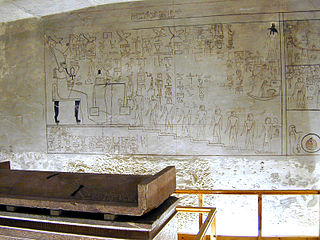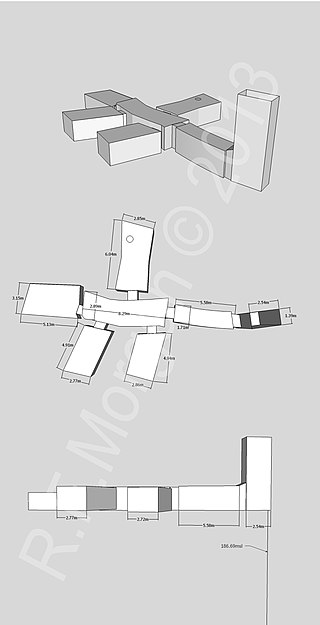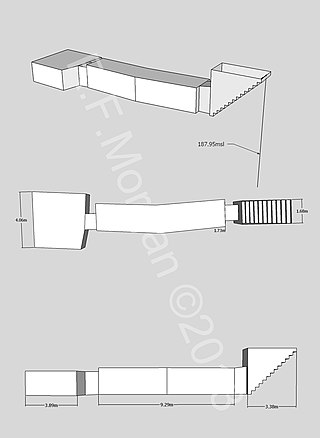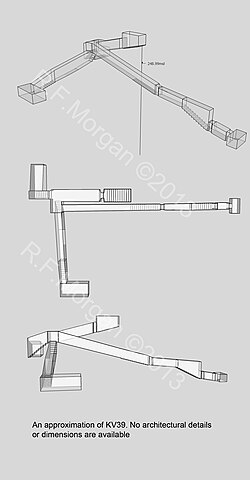
KV55 is a tomb in the Valley of the Kings in Egypt. It was discovered by Edward R. Ayrton in 1907 while he was working in the Valley for Theodore M. Davis. It has long been speculated, as well as much disputed, that the body found in this tomb was that of the famous king, Akhenaten, who moved the capital to Akhetaten. The results of genetic and other scientific tests published in February 2010 have confirmed that the person buried there was both the son of Amenhotep III and the father of Tutankhamun. Furthermore, the study established that the age of this person at the time of his death was consistent with that of Akhenaten, thereby making it almost certain that it is Akhenaten's body. However, a growing body of work soon began to appear to dispute the assessment of the age of the mummy and the identification of KV55 as Akhenaten.

Thutmose I was the third pharaoh of the 18th Dynasty of Egypt. He received the throne after the death of the previous king, Amenhotep I. During his reign, he campaigned deep into the Levant and Nubia, pushing the borders of Egypt farther than ever before in each region. He also built many temples in Egypt, and a tomb for himself in the Valley of the Kings; he is the first king confirmed to have done this.

Tomb WV22, also known as KV22, was the burial place of Amenhotep III, a pharaoh of the Eighteenth Dynasty, in the western arm of the Valley of the Kings. The tomb is unique in that it has two subsidiary burial chambers for the pharaoh's wives Tiye and Sitamen. It was officially discovered in August 1799 by Prosper Jollois and Édouard de Villiers du Terrage, engineers with Napoleon's expedition to Egypt but had probably been open for some time. The tomb was first excavated in the early 1900s by Theodore M. Davis; the details of this are lost. The first documented clearance was carried out by Howard Carter in 1915. Since 1989, a Japanese team from Waseda University led by Sakuji Yoshimura and Jiro Kondo has excavated and conserved the tomb. The sarcophagus is missing from the tomb. The tomb's layout and decoration follow the tombs of the king's predecessors, Amenhotep II (KV35) and Thutmose IV (KV43); however, the decoration is much finer in quality. Several images of the pharaoh's head have been cut out and can be seen today in the Louvre.

Tomb KV42 is an ancient Egyptian tomb in the Valley of the Kings near Luxor, Egypt. It was constructed for Hatshepsut-Meryetre, the wife of Thutmose III, but she was not buried in the tomb. It may have been reused by Sennefer, a mayor of Thebes during the reign of Amenhotep II, and by several members of his family. The tomb has a cartouche-shaped burial chamber, like other early Eighteenth Dynasty tombs.

Tomb KV43 is the burial place of Thutmose IV, a pharaoh of the Eighteenth Dynasty in the Valley of the Kings in Luxor, Egypt. He was interred with two of his children who predeceased him. The tomb has a dog-leg shape, typical of the layout of early Eighteenth dynasty tombs. KV43 was rediscovered in 1903 by Howard Carter, excavating on behalf of Theodore M. Davis.

Tomb KV35 is the tomb of Pharaoh Amenhotep II located in the Valley of the Kings in Luxor, Egypt. Later, it was used as a cache for other royal mummies. It was discovered by Victor Loret in March 1898.

KV4 is a tomb in the Valley of the Kings (Egypt). The tomb was initiated for the burial of Ramesses XI but it is likely that its construction was abandoned and it was not used for Ramesses's interment. It also seems likely that Pinedjem I intended to usurp this tomb for his own burial, but that he too abandoned the plan. KV4 is notable for being the last royal tomb that was quarried in the Valley and because it has been interpreted as being a workshop used during the official dismantling of the royal necropolis in the early Third Intermediate Period.

Tomb KV36 is the burial place of the noble Maiherpri of the Eighteenth Dynasty in the Valley of the Kings, Egypt.

Tomb KV57 is the royal tomb of Horemheb, the last pharaoh of the Eighteenth Dynasty and is located in the Valley of the Kings, Egypt.

Tomb KV26 is an ancient Egyptian tomb of the Eighteenth Dynasty located in Egypt's Valley of the Kings. It is located in a side valley leading to the tomb of Thutmose III (KV34). It was visited by the early Egyptologist James Burton in the 1820s or 1830s, and by Victor Loret in 1898. It was mapped in the 1980s by the Theban Mapping Project. The first documented excavation of the tomb was carried out in 2009 by the University of Basel's Kings' Valley Project. The tomb contained evidence of at least one burial and fragmented pottery and stone vessels of mid-Eighteenth Dynasty date but nothing is known about its occupant(s).

Tomb KV30 is an ancient Egyptian tomb located in the Valley of the Kings in Egypt. It likely dates to the mid-Eighteenth Dynasty and was used for the burial of an unknown individual. It may have been discovered by Giovanni Belzoni in 1817, working on a commission from the 2nd Earl Belmore. It was excavated between 2009 and 2010 by the University of Basel's Kings' Valley Project.
Tomb KV29 is an ancient Egyptian tomb in the Valley of the Kings, in the Theban Necropolis of Egypt. It is located near the mid-Eighteenth Dynasty tombs of Tiaa (KV32), Thutmose II or Merytre-Hatshepsut (KV42), and Thutmose III (KV34). The tomb was known since the 1830s and given the number KV29 in 1899 but no records of an earlier excavation exist. The entrance shaft was previously planned by the Theban Mapping Project in the 1990s. The tomb was first excavated by the University of Basel King's Valley Project in 2011. Excavation continued in 2016 but the rest of the tomb is filled with debris and its layout is unknown.
Tomb KV33 is an ancient Egyptian tomb in the Valley of the Kings in Egypt. It is located close to the tomb of Thutmose III, KV34. The tomb dates to the mid-Eighteenth Dynasty and was used for the burial of an unknown individual. The layout is simple, consisting of descending steps and a main chamber with two adjoining rooms. KV33 was discovered by Victor Loret in 1898. The small tomb was open to visitors in the early 1900s when it was described in a tourist guidebook. In modern times, a bench was built over the entrance. In 2012 the tomb was excavated for the first time by the University of Basel's Kings' Valley Project.

Tomb KV37 is an ancient Egyptian tomb in the Valley of the Kings near Luxor, Egypt. Bone fragments and white-washed storage jars indicate that the tomb was used for a burial, probably in the Eighteenth Dynasty. However, its original occupants are unknown.

Tomb KV21 is an ancient Egyptian tomb located in the Valley of the Kings in Egypt. It was discovered in 1817 by Giovanni Belzoni and later re-excavated by Donald P. Ryan in 1989. It contains the mummies of two women, thought to be Eighteenth Dynasty queens. In 2010, a team headed by Zahi Hawass used DNA evidence to tentatively identify one mummy, KV21A, as the biological mother of the two fetuses preserved in the tomb of King Tutankhamun.

The Valley of the Kings, also known as the Valley of the Gates of the Kings, is an area in Egypt where, for a period of nearly 500 years from the Eighteenth Dynasty to the Twentieth Dynasty, rock-cut tombs were excavated for pharaohs and powerful nobles under the New Kingdom of ancient Egypt.

KV64 is the tomb of an unknown Eighteenth Dynasty individual in the Valley of the Kings, near Luxor, Egypt that was re-used in the Twenty-second Dynasty for the burial of the priestess Nehmes Bastet, who held the office of "chantress" at the temple of Karnak. The tomb is located on the pathway to KV34 in the main Valley of the Kings. KV64 was discovered in 2011 and excavated in 2012 by Susanne Bickel and Elina Paulin-Grothe of the University of Basel.

Tiaa or Tia'a was an ancient Egyptian queen consort during the Eighteenth Dynasty of Egypt. She was a "faceless concubine" during the time of Amenhotep II who withheld from her the title Great Royal Wife, but when her son Thutmose IV became pharaoh, he performed a revision of her status and gave her that title.

The tomb of Kha and Merit, also known by its tomb number TT8, is the funerary chapel and burial place of the ancient Egyptian foreman Kha and his wife Merit, in the northern cemetery of the workmen's village of Deir el-Medina. Active during the mid-Eighteenth Dynasty, Kha supervised the workforce who constructed royal tombs in the reigns of pharaohs Amenhotep II, Thutmose IV and Amenhotep III. Of unknown background, he probably rose to this position through skill and was rewarded by at least one king. He and his wife Merit had three known children. Kha died in his 50s or 60s, while Merit died before him, seemingly unexpectedly, in her 30s.

Menhet, Menwi and Merti, also spelled Manhata, Manuwai and Maruta, were three minor foreign-born wives of Pharaoh Thutmose III of the Eighteenth Dynasty. They are known for their lavishly furnished rock-cut tomb in Wady Gabbanat el-Qurud near Luxor, Egypt. They are suggested to be Syrian, as the names all fit into Canaanite name forms, although their ultimate origin is unknown. A West Semitic origin is likely, but both West Semitic and Hurrian derivations have been suggested for Menwi. Each of the wives bear the title of "king's wife", and were likely only minor members of the royal harem. It is not known if the women were related as the faces on the lids of their canopic jars are all different.



















